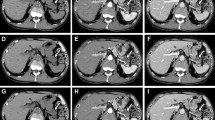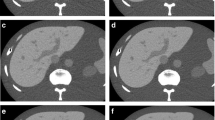Abstract
Objectives
To investigate the feasibility of low-radiation dose and low iodinated contrast medium (ICM) dose protocol combining low-tube voltage and deep-learning reconstruction (DLR) algorithm in thin-slice abdominal CT.
Methods
This prospective study included 148 patients who underwent contrast-enhanced abdominal CT with either 120-kVp (600 mgL/kg, n = 74) or 80-kVp protocol (360 mgL/kg, n = 74). The 120-kVp images were reconstructed using hybrid iterative reconstruction (HIR) (120-kVp-HIR), while 80-kVp images were reconstructed using HIR (80-kVp-HIR) and DLR (80-kVp-DLR) with 0.5 mm thickness. Size-specific dose estimate (SSDE) and iodine dose were compared between protocols. Image noise, CT attenuation, and contrast-to-noise ratio (CNR) were quantified. Noise power spectrum (NPS) and edge rise slope (ERS) were used to evaluate noise texture and edge sharpness, respectively. The subjective image quality was rated on a 4-point scale.
Results
SSDE and iodine doses of 80-kVp were 40.4% (8.1 ± 0.9 vs. 13.6 ± 2.7 mGy) and 36.3% (21.2 ± 3.9 vs. 33.3 ± 4.3 gL) lower, respectively, than those of 120-kVp (both, p < 0.001). CT attenuation of vessels and solid organs was higher in 80-kVp than in 120-kVp images (all, p < 0.001). Image noise of 80-kVp-HIR and 80-kVp-DLR was higher and lower, respectively than that of 120-kVp-HIR (both p < 0.001). The highest CNR and subjective scores were attained in 80-kVp-DLR (all, p < 0.001). There were no significant differences in average NPS frequency and ERS between 120-kVp-HIR and 80-kVp-DLR (p ≥ 0.38).
Conclusion
Compared with the 120-kVp-HIR protocol, the combined use of 80-kVp and DLR techniques yielded superior subjective and objective image quality with reduced radiation and ICM doses at thin-section abdominal CT.
Clinical relevance statement
Scanning at low-tube voltage (80-kVp) combined with the deep-learning reconstruction algorithm may enhance diagnostic efficiency and patient safety by improving image quality and reducing radiation and contrast doses of thin-slice abdominal CT.
Key Points
-
Reducing radiation and iodine doses is desirable; however, contrast and noise degradation can be detrimental.
-
The 80-kVp scan with the deep-learning reconstruction technique provided better images with lower radiation and contrast doses.
-
This technique may be efficient for improving diagnostic confidence and patient safety in thin-slice abdominal CT.






Similar content being viewed by others
Abbreviations
- CNR:
-
Contrast-to-noise ratio
- DLR:
-
Deep-learning-based reconstruction
- ERS:
-
Edge rise slope
- HIR:
-
Hybrid iterative reconstruction
- ICM:
-
Iodinated contrast medium
- NPS:
-
Noise power spectrum
- SSDE:
-
Size-specific dose estimate
References
Rehani MM, Yang K, Melick ER et al (2020) Patients undergoing recurrent CT scans: assessing the magnitude. Eur Radiol 30:1828–1836
Bosch de Basea Gomez M, Thierry-Chef I, Harbron R et al (2023) Risk of hematological malignancies from CT radiation exposure in children, adolescents and young adults. Nat Med 29:3111–3119
Gupta S, Motwani SS, Seitter RH et al (2023) Development and validation of a risk model for predicting contrast-associated acute kidney injury in patients with cancer: evaluation in over 46,000 CT examinations. AJR Am J Roentgenol 221:486–501
Dekker HM, Stroomberg GJ, Prokop M (2022) Tackling the increasing contamination of the water supply by iodinated contrast media. Insights Imaging 13:30
Grist TM, Canon CL, Fishman EK, Kohi MP, Mossa-Basha M (2022) Short-, mid-, and long-term strategies to manage the shortage of iohexol. Radiology 304:289–293
Nakayama Y, Awai K, Funama Y et al (2005) Abdominal CT with low tube voltage: preliminary observations about radiation dose, contrast enhancement, image quality, and noise. Radiology 237:945–951
Nagayama Y, Oda S, Nakaura T et al (2018) Radiation dose reduction at pediatric CT: use of low tube voltage and iterative reconstruction. Radiographics 38:1421–1440
Nakaura T, Nakamura S, Maruyama N et al (2012) Low contrast agent and radiation dose protocol for hepatic dynamic CT of thin adults at 256-detector row CT: effect of low tube voltage and hybrid iterative reconstruction algorithm on image quality. Radiology 264:445–454
Schindera ST, Nelson RC, Mukundan Jr S et al (2008) Hypervascular liver tumors: low tube voltage, high tube current multi-detector row CT for enhanced detection-phantom study. Radiology 246:125–132
Marin D, Nelson RC, Samei E et al (2009) Hypervascular liver tumors: low tube voltage, high tube current multidetector CT during late hepatic arterial phase for detection-initial clinical experience. Radiology 251:771–779
Sprawls P (1992) AAPM tutorial. CT image detail and noise. Radiographics 12:1041–1046
Schindera ST, Torrente JC, Ruder TD et al (2011) Decreased detection of hypovascular liver tumors with MDCT in obese patients: a phantom study. AJR Am J Roentgenol 196:W772–W776
Nagayama Y, Tanoue S, Tsuji A et al (2018) Application of 80-kVp scan and raw data-based iterative reconstruction for reduced iodine load abdominal-pelvic CT in patients at risk of contrast-induced nephropathy referred for oncological assessment: effects on radiation dose, image quality and renal function. Br J Radiol 91:20170632
Mileto A, Zamora DA, Alessio AM et al (2018) CT detectability of small low-contrast hypoattenuating focal lesions: iterative reconstructions versus filtered back projection. Radiology 289:443–454
Jensen CT, Wagner-Bartak NA, Vu LN et al (2019) Detection of colorectal hepatic metastases is superior at standard radiation dose CT versus reduced dose CT. Radiology 290:400–409
Mileto A, Guimaraes LS, McCollough CH, Fletcher JG, Yu L (2019) State of the art in abdominal CT: the limits of iterative reconstruction algorithms. Radiology 293:491–503
Samei E, Bakalyar D, Boedeker KL et al (2019) Performance evaluation of computed tomography systems: Summary of AAPM Task Group 233. Med Phys 46:e735–e756
Ishihara M, Shiiba M, Maruno H et al (2023) Detection of intracranial aneurysms using deep learning-based CAD system: usefulness of the scores of CNN’s final layer for distinguishing between aneurysm and infundibular dilatation. Jpn J Radiol 41:131–141
Toda N, Hashimoto M, Iwabuchi Y et al (2023) Validation of deep learning-based computer-aided detection software use for interpretation of pulmonary abnormalities on chest radiographs and examination of factors that influence readers’ performance and final diagnosis. Jpn J Radiol 41:38–44
Ozaki J, Fujioka T, Yamaga E et al (2022) Deep learning method with a convolutional neural network for image classification of normal and metastatic axillary lymph nodes on breast ultrasonography. Jpn J Radiol 40:814–822
Takamatsu A, Ueno M, Yoshida K, Kobayashi T, Kobayashi S, Gabata T (2023) Performance of artificial intelligence-based software for the automatic detection of lung lesions on chest radiographs of patients with suspected lung cancer. Jpn J Radiol 42:291–299
Nakaura T, Yoshida N, Kobayashi N et al (2023) Preliminary assessment of automated radiology report generation with generative pre-trained transformers: comparing results to radiologist-generated reports. Jpn J Radiol 42:190–200
Nakaura T, Kobayashi N, Yoshida N et al (2023) Update on the use of artificial intelligence in hepatobiliary MR imaging. Magn Reson Med Sci 22:147–156
Nagayama Y, Sakabe D, Goto M et al (2021) Deep learning–based reconstruction for lower-dose pediatric CT: technical principles, image characteristics, and clinical implementations. Radiographics 41:1936–1953
Ueda D, Kakinuma T, Fujita S et al (2024) Fairness of artificial intelligence in healthcare: review and recommendations. Jpn J Radiol 42:3–15
Nagayama Y, Goto M, Sakabe D et al (2022) Radiation dose optimization potential of deep learning-based reconstruction for multiphase hepatic CT: a clinical and phantom study. Eur J Radiol 151:110280
Goto M, Nagayama Y, Sakabe D et al (2023) Lung-optimized deep-learning-based reconstruction for ultralow-dose CT. Acad Radiol 30:431–440
Zhao R, Sui X, Qin R et al (2022) Can deep learning improve image quality of low-dose CT: a prospective study in interstitial lung disease. Eur Radiol 32:8140–8151
Kaga T, Noda Y, Mori T et al (2022) Unenhanced abdominal low-dose CT reconstructed with deep learning-based image reconstruction: image quality and anatomical structure depiction. Jpn J Radiol 40:703–711
Funama Y, Nakaura T, Hasegawa A et al (2023) Noise power spectrum properties of deep learning–based reconstruction and iterative reconstruction algorithms: phantom and clinical study. Eur J Radiol 165:110914
Nagayama Y, Goto M, Sakabe D et al (2022) Radiation dose reduction for 80-kVp pediatric CT using deep learning-based reconstruction: a clinical and phantom study. AJR Am J Roentgenol 219:315–324
Nagayama Y, Iwashita K, Maruyama N et al (2023) Deep learning-based reconstruction can improve the image quality of low radiation dose head CT. Eur Radiol 33:3253–3265
Higaki T, Nakamura Y, Zhou J et al (2020) Deep learning reconstruction at CT: phantom study of the image characteristics. Acad Radiol 27:82–87
Greffier J, Hamard A, Pereira F et al (2020) Image quality and dose reduction opportunity of deep learning image reconstruction algorithm for CT: a phantom study. Eur Radiol 30:3951–3959
Solomon J, Lyu P, Marin D, Samei E (2020) Noise and spatial resolution properties of a commercially available deep learning-based CT reconstruction algorithm. Med Phys 47:3961–3971
Kang H (2021) Sample size determination and power analysis using the G*Power software. J Educ Eval Health Prof 18:17
AAPM Report 204. Size-specific dose estimates (SSDE) in pediatric and adult CT examinations. https://www.aapm.org/pubs/reports/RPT_204.pdf
Tatsugami F, Higaki T, Sakane H et al (2017) Coronary artery stent evaluation with model-based iterative reconstruction at coronary CT angiography. Acad Radiol 24:975–981
Tatsugami F, Higaki T, Nakamura Y et al (2019) Deep learning-based image restoration algorithm for coronary CT angiography. Eur Radiol 29:5322–5329
Mergen V, Sartoretti T, Baer-Beck M et al (2022) Ultra-high-resolution coronary CT angiography with photon-counting detector CT: feasibility and image characterization. Invest Radiol 57:780–788
Kanda Y (2013) Investigation of the freely available easy-to-use software ‘EZR’ for medical statistics. Bone Marrow Transplantation 48:452–458
Oostveen LJ, Smit EJ, Dekker HM et al (2023) Abdominopelvic CT image quality: evaluation of thin (0.5-mm) slices using deep learning reconstruction. AJR Am J Roentgenol 220:381–388
Jensen CT, Gupta S, Saleh MM et al (2022) Reduced-dose deep learning reconstruction for abdominal CT of liver metastases. Radiology 303:90–98
Toia GV, Zamora DA, Singleton M et al (2023) Detectability of small low-attenuation lesions with deep learning CT image reconstruction: a 24-reader phantom study. AJR Am J Roentgenol 220:283–295
Lyu P, Liu N, Harrawood B et al (2023) Is it possible to use low-dose deep learning reconstruction for the detection of liver metastases on CT routinely? Eur Radiol 33:1629–1640
Achenbach S, Chandrashekhar Y, Narula J (2013) The ethics of publishing medical imaging research. JACC Cardiovasc Imaging 6:1351–1353
Akagi M, Nakamura Y, Higaki T, Narita K, Honda Y, Awai K (2020) Deep learning reconstruction of equilibrium phase CT images in obese patients. Eur J Radiol 133:109349
Wang H, Yue S, Liu N et al (2024) Deep learning reconstruction vs standard reconstruction for abdominal CT: the influence of BMI. Eur Radiol 34:1614–1623
Greffier J, Frandon J, Si-Mohamed S et al (2021) Comparison of two deep learning image reconstruction algorithms in chest CT images: A task-based image quality assessment on phantom data. Diagn Interv Imaging 103:21–30
Kawashima H, Ichikawa K, Takata T, Seto I (2022) Comparative assessment of noise properties for two deep learning CT image reconstruction techniques and filtered back projection. Med Phys 49:6359–6367
Funding
The authors state that this work has not received any funding.
Author information
Authors and Affiliations
Corresponding author
Ethics declarations
Guarantor
The scientific guarantor of this publication is Toru Beppu.
Conflict of interest
Toshinori Hirai has received research support from Canon Medical Systems. The Canon Medical Systems had no control over the interpretation, writing, or publication of this work.
Statistics and biometry
No complex statistical methods were necessary for this paper.
Informed consent
Written informed consent was obtained from all subjects (patients) in this study.
Ethical approval
Institutional Review Board approval was obtained.
Study subjects or cohorts overlap
No study subject or cohort overlap has been reported.
Methodology
-
Prospective
-
Observational
-
Performed at one institution
Additional information
Publisher’s Note Springer Nature remains neutral with regard to jurisdictional claims in published maps and institutional affiliations.
Rights and permissions
Springer Nature or its licensor (e.g. a society or other partner) holds exclusive rights to this article under a publishing agreement with the author(s) or other rightsholder(s); author self-archiving of the accepted manuscript version of this article is solely governed by the terms of such publishing agreement and applicable law.
About this article
Cite this article
Yoshida, K., Nagayama, Y., Funama, Y. et al. Low tube voltage and deep-learning reconstruction for reducing radiation and contrast medium doses in thin-slice abdominal CT: a prospective clinical trial. Eur Radiol (2024). https://doi.org/10.1007/s00330-024-10793-6
Received:
Revised:
Accepted:
Published:
DOI: https://doi.org/10.1007/s00330-024-10793-6




